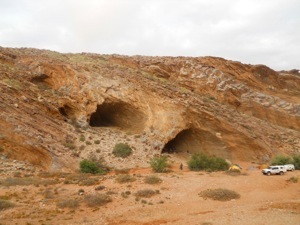<< Our Photo Pages >> Spitzkloof - Cave or Rock Shelter in South Africa
Submitted by bat400 on Wednesday, 10 October 2012 Page Views: 4647
Natural PlacesSite Name: SpitzkloofCountry: South Africa
NOTE: This site is 89.673 km away from the location you searched for.
Type: Cave or Rock Shelter
Nearest Town: Port Nolloth Nearest Village: Lekkersing
Latitude: 28.87S Longitude: 17.050000E
Condition:
| 5 | Perfect |
| 4 | Almost Perfect |
| 3 | Reasonable but with some damage |
| 2 | Ruined but still recognisable as an ancient site |
| 1 | Pretty much destroyed, possibly visible as crop marks |
| 0 | No data. |
| -1 | Completely destroyed |
| 5 | Superb |
| 4 | Good |
| 3 | Ordinary |
| 2 | Not Good |
| 1 | Awful |
| 0 | No data. |
| 5 | Can be driven to, probably with disabled access |
| 4 | Short walk on a footpath |
| 3 | Requiring a bit more of a walk |
| 2 | A long walk |
| 1 | In the middle of nowhere, a nightmare to find |
| 0 | No data. |
| 5 | co-ordinates taken by GPS or official recorded co-ordinates |
| 4 | co-ordinates scaled from a detailed map |
| 3 | co-ordinates scaled from a bad map |
| 2 | co-ordinates of the nearest village |
| 1 | co-ordinates of the nearest town |
| 0 | no data |
Be the first person to rate this site - see the 'Contribute!' box in the right hand menu.
Internal Links:
External Links:
I have visited· I would like to visit
bat400 would like to visit

Excavations by the AMEMSA Project (Adaptations to Marginal Environments in the Middle Stone Age) beginning in 2009 have found stone tools, hearth sites, and decorated ostrich egg fragments from 60,000 years ago.
Located in the Richtersveld - an extension of the Namib Desert. The rockshelter is one of three dome shaped hollows eroded from an outcrop of quartzite, near a dry tributary of the Holgat River.
Note: the location given is only aproximate.
Ref:
AMEMSA.
Genevieve Dewara, Brian A. Stewartb, "Preliminary results of excavations at Spitzkloof Rockshelter, Richtersveld, SouthAfrica", Quaternary International, Vol. 270, 23 August 2012, Pages 30–39.
Note: Hunting for the world’s oldest decorated eggs from the Middle Stone Age in South Africa.
You may be viewing yesterday's version of this page. To see the most up to date information please register for a free account.
Do not use the above information on other web sites or publications without permission of the contributor.
Nearby Images from Flickr

The above images may not be of the site on this page, but were taken nearby. They are loaded from Flickr so please click on them for image credits.
Click here to see more info for this site
Nearby sites
Click here to view sites on an interactive map of the areaKey: Red: member's photo, Blue: 3rd party photo, Yellow: other image, Green: no photo - please go there and take one, Grey: site destroyed
Download sites to:
KML (Google Earth)
GPX (GPS waypoints)
CSV (Garmin/Navman)
CSV (Excel)
To unlock full downloads you need to sign up as a Contributory Member. Otherwise downloads are limited to 50 sites.
Turn off the page maps and other distractions
Nearby sites listing. In the following links * = Image available
128.5km N 2° Apollo 11 Cave* Cave or Rock Shelter
340.4km NE 46° The Lost City of Kalahari* Ancient Village or Settlement
413.5km SSE 161° Diepkloof* Rock Outcrop
577.2km SSE 167° Iziko South African Museum Museum
601.7km E 79° Kathu Pan* Ancient Mine, Quarry or other Industry
625.6km NNW 344° Mirabib* Natural Stone / Erratic / Other Natural Feature
641.2km N 351° Rooisand Rock Painting* Rock Art
646.5km E 81° Wonderwerk Cave* Cave or Rock Shelter
700.5km E 92° Driekopseiland Rock Art Rock Art
710.0km E 97° Thomas' Farm Belmont Rock Art Rock Art
731.7km SSE 148° Blombos Cave* Cave or Rock Shelter
737.5km E 89° Nooitgedacht Rock art Rock Art
741.1km E 90° Wildebeestkuil* Rock Art
753.2km E 91° McGregor Museum Museum
761.6km SE 142° Pinnacle Point* Cave or Rock Shelter
793.1km N 356° Oropoko* Rock Art
795.2km N 352° Paula's Cave Rock Art
798.8km N 349° Phillipp's Cave Rock Art
803.6km E 84° Stowlands Rock art Rock Art
805.0km NNW 346° Bushman Paradise* Rock Art
895.2km E 80° Wolmaransstad Rock Art Rock Art
895.7km NNW 344° The White Lady Group* Rock Art
906.7km SE 132° Klasies River Caves* Cave or Rock Shelter
952.8km N 350° Omburo Ost* Rock Art
957.8km N 350° Vingerklip* Natural Stone / Erratic / Other Natural Feature
View more nearby sites and additional images






 We would like to know more about this location. Please feel free to add a brief description and any relevant information in your own language.
We would like to know more about this location. Please feel free to add a brief description and any relevant information in your own language. Wir möchten mehr über diese Stätte erfahren. Bitte zögern Sie nicht, eine kurze Beschreibung und relevante Informationen in Deutsch hinzuzufügen.
Wir möchten mehr über diese Stätte erfahren. Bitte zögern Sie nicht, eine kurze Beschreibung und relevante Informationen in Deutsch hinzuzufügen. Nous aimerions en savoir encore un peu sur les lieux. S'il vous plaît n'hesitez pas à ajouter une courte description et tous les renseignements pertinents dans votre propre langue.
Nous aimerions en savoir encore un peu sur les lieux. S'il vous plaît n'hesitez pas à ajouter une courte description et tous les renseignements pertinents dans votre propre langue. Quisieramos informarnos un poco más de las lugares. No dude en añadir una breve descripción y otros datos relevantes en su propio idioma.
Quisieramos informarnos un poco más de las lugares. No dude en añadir una breve descripción y otros datos relevantes en su propio idioma.